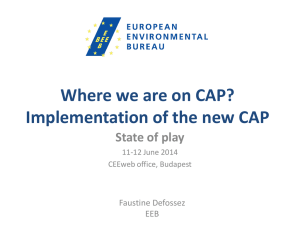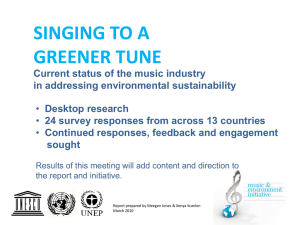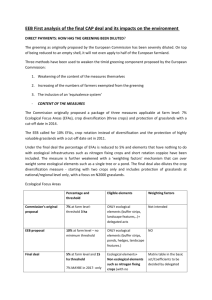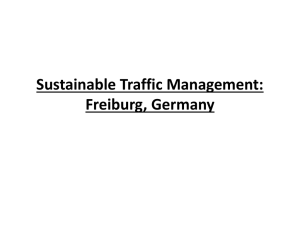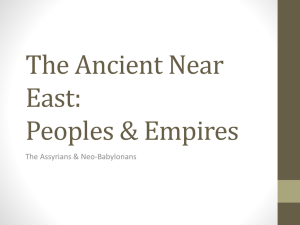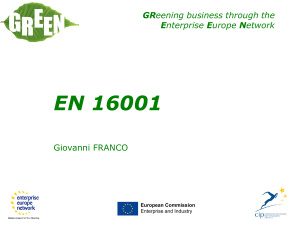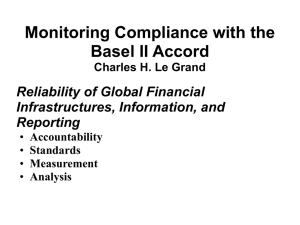New Directions in European Agricultural Policy
advertisement
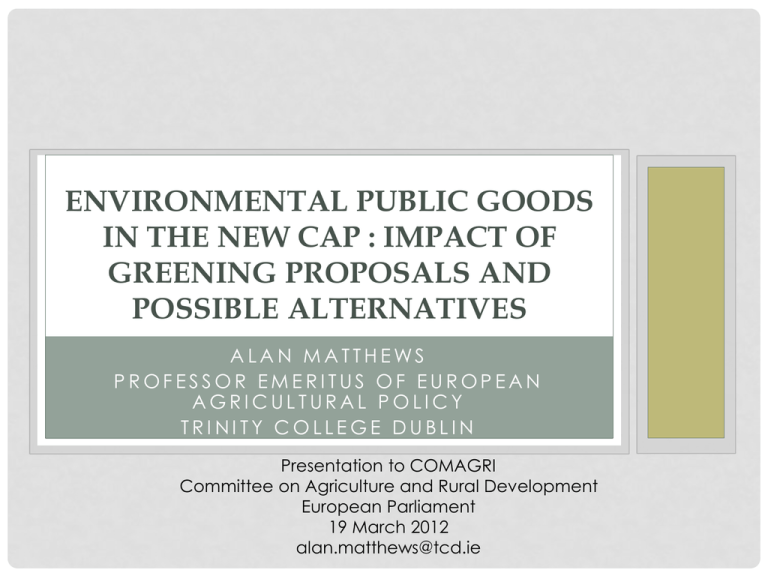
ENVIRONMENTAL PUBLIC GOODS IN THE NEW CAP : IMPACT OF GREENING PROPOSALS AND POSSIBLE ALTERNATIVES ALAN MATTHEWS PROFESSOR EMERITUS OF EUROPEAN AGRICULTURAL POLICY TRINITY COLLEGE DUBLIN Presentation to COMAGRI Committee on Agriculture and Rural Development European Parliament 19 March 2012 alan.matthews@tcd.ie GREENING THE CAP: BASIC PRINCIPLES • Greening is unavoidable given the challenges faced by the natural environment • • • • • • Biodiversity Soils Water Climate change Pests and diseases Loss of ecosystem services GREENING THE CAP: BASIC PRINCIPLES • That greening might have an opportunity cost in terms of foregone output is not a justification to ignore greening • Costs of greening are relatively modest • Environmental sustainability and food production can be complements rather than substitutes in the longer-term • Biofuel policies of dubious merit have much greater impact on food production capacity • Higher world food prices justify shifting more of the CAP budget towards nature, not less • Assumption that farmers are worse off with greening ignores budget realities and market feedback effects GREENING THE CAP: BASIC PRINCIPLES • That the CAP must be greened is not a justification to ignore the evidence on how to do this in the most cost-effective manner • Any trade-off with food production should be minimised • The environmental benefits should justify the amount of taxpayer resources committed • It is appropriate to evaluate the Commission’s proposals from this perspective GREENING IN THE CURRENT CAP • Mandatory greening through cross-compliance in Pillar 1 • Voluntary enhanced greening through multi-annual, contractual, agri-environment schemes in Pillar 2 • Greening in Pillar 1 introduced in 2009 in Article 68 for first time THE COMMISSION’S PROPOSALS • Commission legislative proposal Oct 2011 • An important element is to enhance the overall environmental performance of the CAP through the greening of direct payments by means of certain agricultural practices beneficial for the climate and the environment that all farmers will have to follow, which go beyond cross compliance and are in turn the basis for pillar II measures. • A payment (30% of annual national ceiling) for farmers following agricultural practices beneficial for the climate and the environment: crop diversification, maintenance of permanent pastures and ecological focus areas. Organic farming automatically benefits from this payment. THE NOVELTY OF THE COMMISSION’S PROPOSALS • Mandatory greening in Pillar 1 • Why? • Universal – low uptake of current AES in intensivelyfarmed areas • Visibility – helps to legitimise direct payments • Lack of political support to further increase funding for Pillar 2 – the end of the Fischler decade! • How? • Simple – AES schemes have high transactions costs • Generalised – Homogenous measures across whole of EU • Annual – Must be executable and verifiable within each calendar year INITIAL REACTIONS • If truly mandatory, farmers will not receive basic income payment unless they comply with greening measures • A form of super cross-compliance • Why have two payments with separate inspection and monitoring requirements? • If truly voluntary, farmers receive the additional greening payment if they decide to opt in • A form of shallow AEM • Why put in Pillar 1? The logical framework for analysis of the Commission’s proposals ECOLOGICAL FOCUS AREAS • Farmers shall ensure that at least 7 % of their eligible hectares, excluding areas under permanent grassland, is ecological focus area such as land left fallow, terraces, landscape features, buffer strips and afforested areas (+ other areas to be defined). • Commission IA projects that 46% of farms would have to set aside additional land with 5% EFA (but only fallow land considered) ECOLOGICAL FOCUS AREAS • Ecological Focus Areas (EFAs) can potentially provide important environmental benefits. • It is important to establish whether its environmental benefits can be achieved by focusing mainly on less productive land or whether a more uniform distribution of EFAs over the EU land area is required – the issue of uniformity. • • The environmental benefits of EFAs depend on area, location, management, connectivity and provision of advice. • • The effects of EFAs on production will depend on which landscape features, land use and management practices are permitted. ECOLOGICAL FOCUS AREAS • Basis for the 7% threshold? Should it be more or less? • Definition of the base area (treatment of temporary grassland, perennial crops) • Administrative complications in measuring EFAs • Should EFAs be a universal requirement? • Link to area’s biodiversity status? • Link to opportunity cost of creating biodiversity? • Allow for trading of EFA ‘quotas’ ECOLOGICAL FOCUS AREAS • How to encourage appropriate management of EFAs • • • • Encourage AES uptake through higher co-financing) Linking up EFAs to form ‘green infrastructure’ (Swiss model) Possible role for thematic sub-programmes in Pillar 2. Encourage collective models • Implementing EFAs at farm level • How measured on fragmented farms? • Implementation on large farms? • Change focus from land area covered by EFA to measuring environmental benefit per ha, with each holding required to deliver a minimum amount of ecological benefit CROP DIVERSIFICATION • Where the arable land of the farmer covers more than 3 hectares and is not entirely used for grass production (sown or natural), entirely left fallow or entirely cultivated with crops under water for a significant part of the year, cultivation on the arable land shall consist of at least three different crops. None of those three crops shall cover less than 5 % of the arable land and the main one shall not exceed 70 % of the arable land. • Article 30 DP Regulation CROP DIVERSIFICATION • Crop diversification can have environmental benefits but these are likely to be less than for crop rotation, which is ruled out as an annual measure by the Commission for administrative reasons. • • Commission impact assessment suggests 2% arable area will be affected by this measure and about 8% of holdings will bear a cost, which could be quite substantial, but other studies suggest higher figures • Impact depends on definition of a crop CROP DIVERSIFICATION • Treatment of permanent crops (e.g. vineyards) • Treatment of mixed livestock farms growing small area of feed (exempt holdings with more than, say, 70% permanent grassland from arable requirements, or have a graduated system) • High costs for farmers with small arable areas (raise the 3 ha threshold?) • To maximise environmental benefits, some NGOs favour specifying a leguminous crop but this would risk the measure’s claim to WTO green box status • Some MS arguing that 70% threshold could be raised (e.g. to 85%) without losing environmental benefits MAINTAINING PERMANENT PASTURE • Farmers shall maintain as permanent grassland the areas of their holdings declared as such … for claim year 2014, hereinafter referred to as “reference areas under permanent grassland”. • Currently Members States must ensure that the ratio of the land under permanent pasture at national level in relation to the total agricultural area should change no more than 10% compared to the baseline year. The Commission proposal places the national requirement at the farm level. MAINTAINING PERMANENT PASTURE • Need to clarify whether objective is primarily climate change mitigation or biodiversity enhancement • Will rotational flexibility be allowed? • Freezes land use unnecessarily at farm level when it is the national (regional) totals that are important • Administrative complications because management practice has to be tracked over 5-year period • Fails to focus sufficient support on high nature value grasslands • The 2014 reference is counter-productive and may encourage the ploughing of grasslands before that date POSSIBLE OTHER PILLAR 1 MEASURES • • • • Crop rotation Green cover Premium for high nature value grassland Green growth measures (incentives for resource efficiency, reduced GHG emissions and carbon sequestration) with farmers qualifying by participating in various audit/certification schemes INTRODUCING FLEXIBILITY TO PILLAR 1 MEASURES • The menu approach • The GAEC approach • The ‘green by definition’ approach • Objective is to reduce the rigidities and costs of a ‘one size fits all’ approach • Potential pitfall (?) is differential level of ambition in different MS INTRODUCING FLEXIBILITY TO PILLAR 1 MEASURES • The menu approach – two variants • Choices are defined at EU level from which MS can choose • Choices are defined at MS level from which farmers can choose • At MS level, what other simple, annual, generalisable measures might be added to the list? • Flexibility at farm level (COPA-COGEC green growth scheme, Groupe de Bruges points scheme) would be really difficult to operate as a Pillar 1 scheme • One form of farm-level flexibility is ‘green by definition’ exemption FLEXIBILITY THROUGH ‘GREEN BY DEFINITION’ • The door is opened by the Commission’s proposed treatment of organic farming • “…it may be envisaged that farms (or part thereof) with organic farming certification … receive automatically the greening component since the environmental benefits … from organic farming are at least as high as from the greening measures combined. This should not nonetheless result in reduced support to organic farming under rural development policy, notably agri-environment measures.” (Commission, IA Annex 2). FLEXIBILITY THROUGH ‘GREEN BY DEFINITION’ • Many MS seek wider definition of ‘green by definition’ than just organic farming • Potentially, all farms enrolled in a Pillar 2 AES • But raises the question of double funding for the same practice • Would it lead to additional environment benefit to the taxpayer? RAISING GAEC STANDARDS • In its Impact Assessment, the Commission asks the question: • “To make the greening effective, the measures in the greening component should be compulsory for the farmer, the discretion left to the Member State limited, and sanctions effective. If greening is effectively a requirement in the direct payments system, then wouldn't it be simpler to work instead on enhancing cross compliance?” • IA, Annex 2. RAISING GAEC STANDARDS • To which it gives the following answer: • “Although this line of reasoning is put forth arguably on simplification grounds, it hides the complexities inherent in Member States defining and administering GAEC tailored to regional specificities. As the experience with the optional GAEC on crop rotation has shown, this approach would not necessarily ensure that the entire EU territory is effectively greened. At the same time, it would meet with considerable resistance from farmers as it would be framed as a requirement rather than an incentive, and arguably do away with the political visibility of greening direct payments that is one of the main drivers of this reform.” RAISING GAEC STANDARDS • MS are familiar with implementing GAEC standards • Variation across MS in terms of GAEC definitions • Is this a weakness or a strength? • Farmer perception of greening as an imposition • Not avoided in current proposal • Would lose the political visibility of green payments • Will ultimately be determined by environmental visibility CROSS-CUTTING ISSUES • Why 30% of direct payment envelope? Should it be higher or lower? • What happens to unused green payments? • Implications of the green payment for the speed of transition to regional payment model • Effective monitoring and evaluation methods will be essential to assess the on-going effectiveness of the greening measures. • The smaller farm exemption • The Commission’s proposals could risk the green box status of direct payments in the WTO GREENING THROUGH PILLAR 2 • The viability of any option to purse greening through Pillar 2 depends on an increased budget allocation for this Pillar or greater prioritisation for AEM within the Pillar. • A larger Pillar 2 budget would permit a larger number of farmers to enrol in Pillar 2 AEM but would still be unlikely to cover the whole territory. • The conditional greening proposal that farmers should enter a basic AEM scheme in Pillar 2 in order to be eligible for a payment in Pillar 1 is not relevant at this point in time. • Linking a larger Pillar 2 budget with higher GAEC standards is an attractive option to build on the advantages of a targeted approach while raising minimum standards across the entire land area. Universality Fairness and equity No one approach dominates on all criteria Cost effectiveness Environmental effectiveness Administrative complexity Decision tree responding to Commission proposal
